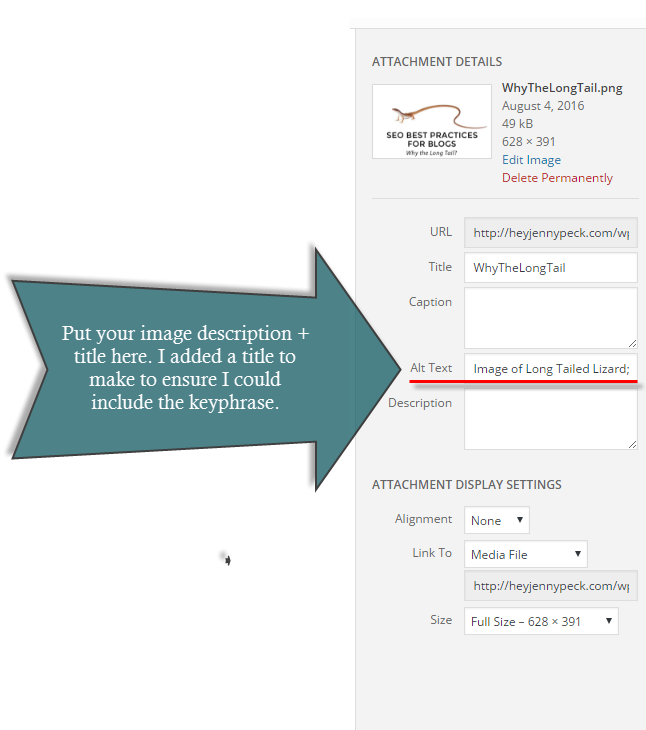
“Why the long tail?”
SEO is constantly evolving, and what worked for you last year may not work in 2018 or beyond. What to do for writing ranking SEO can be a bit of a black box for a lot of people. I’ve been working with a client on improving hers, and so I wanted to share some quick and dirty SEO “best practices” for blogs that you can start using today.
Think about what someone will search for when writing a blog entry. Cater your writing to that search phrase.
Here’s an example. For an explanatory page like this one, I’d imagine people searching along the lines of “SEO best practices for blogs”. This search phrase becomes your “key term”.
While SEO used to be geared towards single key words, search engines have changed their preference towards natural language, or “semantic search”. That is, you will want to aim at what a real person might search for, in words they’ll actually use. When was the last time you did a search with a single word?
This more detailed search is called a “long-tailed keyword”.
Long-tailed keywords encompass individual key words. Ultimately they make up a highly specific 3-6 word phrase that you want to rank for. Get specific and get found!
The more specific your key term, the more your visitors will be targeted to your services and results. Here are some tips to improve your SEO:
-
To come up with a key term, you’ll want to do a little research.
Google the words and phrases you want associated with this blog entry and see what comes back. If the search return is in line with the content you’re producing, you’re on the right track. Yay! Your aim is to have your blog entry rank for a page 1 return among the results that you see. If your results are not aligned with your content, try & try again until you hit the mark.
-
Include your key term in several places.
You’ll want to include the title, the URL, and strategically (not “stuffed” gratuitously!) in at least a few places throughout the entry because repetition is important. You should state it 2 times minimum, ideally 3-4.
-
The key term should also be in the meta description AND in the alt image tag
Include this in both places for the featured image for consistency, because without it your page will simply be ranked lower by “the bots” and you won’t get the traction or views you’re hoping for.
-
When you choose a featured image for your entry, make sure that you complete the alt text field.
“What’s alt text?” you ask?
-
The alt text describes the image
Not limited to users who use screen reader devices due to have impaired vision or disabled images, it is also used by search engine robots (this is how they read images). The alt tag should describe the image and any text included. Plus, hellooooo, insert keyword opportunity!
Put the title in the image to emphasize the key phrase. This improves your SEO and ultimately your page ranking. I’ve settled on the format Image description; Title “x” for the alt text, but it’s pretty flexible. You can describe an image in depth, but don’t go longer than a sentence. You’ll want to know there’s a difference between image titles and image alt text, but I’ll cover that in depth another entry.
-
Want to make things easy on yourself? Use an SEO plugin!
I, along with about a million other people, think the Yoast SEO plugin is a good one. You’ll learn what’s involved by using the plugin’s clear visual signposts. It’s incredibly helpful, especially as you get familiar with what’s involved.
It’s important to keep these things front of mind when you write so your posts will reach more eyeballs. All those eyeballs are what it’s all about, right?! Here are a couple more items I’ll elaborate more on in other entries.
Did you know that videos can also give you 50% better organic results on Google search results.
Have videos? Use them!
Last but not least: Backlinking.
If you have content on your site that’s relevant or can add to the user’s experience? Please link to it!
Backlinks are important for SEO because search engines like Google (who you WANT to like what you’re up to!) will give more credit to websites that have a good number of quality backlinks, and consider the websites that have those links a lot more relevant than those that don’t in their search results pages.
Keep a “best practices” checklist that you go through each time you write until you’ve memorized what’s needed. I hope you got some good quick tips for SEO best practices for blogs. I’ll be fleshing out this topic and more as I go. Meanwhile… good luck!